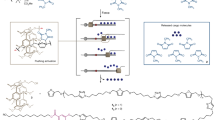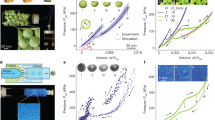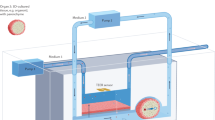Abstract
Living organisms make extensive use of micro- and nanometre-sized pores as gatekeepers for controlling the movement of fluids, vapours and solids between complex environments. The ability of such pores to coordinate multiphase transport, in a highly selective and subtly triggered fashion and without clogging, has inspired interest in synthetic gated pores for applications ranging from fluid processing to 3D printing and lab-on-chip systems1,2,3,4,5,6,7,8,9,10. But although specific gating and transport behaviours have been realized by precisely tailoring pore surface chemistries and pore geometries6,11,12,13,14,15,16,17, a single system capable of controlling complex, selective multiphase transport has remained a distant prospect, and fouling is nearly inevitable11,12. Here we introduce a gating mechanism that uses a capillary-stabilized liquid as a reversible, reconfigurable gate that fills and seals pores in the closed state, and creates a non-fouling, liquid-lined pore in the open state. Theoretical modelling and experiments demonstrate that for each transport substance, the gating threshold—the pressure needed to open the pores—can be rationally tuned over a wide pressure range. This enables us to realize in one system differential response profiles for a variety of liquids and gases, even letting liquids flow through the pore while preventing gas from escaping. These capabilities allow us to dynamically modulate gas–liquid sorting in a microfluidic flow and to separate a three-phase air–water–oil mixture, with the liquid lining ensuring sustained antifouling behaviour. Because the liquid gating strategy enables efficient long-term operation and can be applied to a variety of pore structures and membrane materials, and to micro- as well as macroscale fluid systems, we expect it to prove useful in a wide range of applications.
This is a preview of subscription content, access via your institution
Access options
Subscribe to this journal
Receive 51 print issues and online access
$199.00 per year
only $3.90 per issue
Buy this article
- Purchase on Springer Link
- Instant access to full article PDF
Prices may be subject to local taxes which are calculated during checkout




Similar content being viewed by others
References
Chen, P. C. & Xu, Z. K. Mineral-coated polymer membranes with superhydrophilicity and underwater superoleophobicity for effective oil/water separation. Sci. Rep. 3, 2776 (2013)
Holt, J. K. et al. in Proc. 4th IEEE Conf. Nanotechnol. 110–112 (IEEE, 2004)
Peng, X. S., Jin, J., Nakamura, Y., Ohno, T. & Ichinose, I. Ultrafast permeation of water through protein-based membranes. Nature Nanotechnol. 4, 353–357 (2009)
Paven, M. et al. Super liquid-repellent gas membranes for carbon dioxide capture and heart-lung machines. Nature Commun. 4, 2512 (2013)
Faulkner-Jones, A. et al. Development of a valve-based cell printer for the formation of human embryonic stem cell spheroid aggregates. Biofabrication 5, 015013 (2013)
Oh, K. W. & Ahn, C. H. A review of microvalves. J. Micromech. Microeng. 16, R13–R39 (2006)
Kargov, A. et al. in Proc. IEEE 9th Int. Conf. Rehabilitation Robotics 182–186 (IEEE, 2005)
Edwards, D. A. et al. Large porous particles for pulmonary drug delivery. Science 276, 1868–1872 (1997)
Kralj, J. G., Sahoo, H. R. & Jensen, K. F. Integrated continuous microfluidic liquid-liquid extraction. Lab Chip 7, 256–263 (2007)
Karlsson, J. M. et al. Active liquid degassing in microfluidic systems. Lab Chip 13, 4366–4373 (2013)
Ulbricht, M. Advanced functional polymer membranes. Polymer 47, 2217–2262 (2006)
Lin, N. H., Kim, M. M., Lewis, G. T. & Cohen, Y. Polymer surface nano-structuring of reverse osmosis membranes for fouling resistance and improved flux performance. J. Mater. Chem. 20, 4642–4652 (2010)
Powell, M. R., Cleary, L., Davenport, M., Shea, K. J. & Siwy, Z. S. Electric-field-induced wetting and dewetting in single hydrophobic nanopores. Nature Nanotechnol. 6, 798–802 (2011)
Yameen, B. et al. Ionic transport through single solid-state nanopores controlled with thermally nanoactuated macromolecular gates. Small 5, 1287–1291 (2009)
Wen, Y. Q. et al. DNA-based intelligent logic controlled release systems. Chem. Commun. 48, 8410–8412 (2012)
Adrus, N. & Ulbricht, M. Novel hydrogel pore-filled composite membranes with tunable and temperature-responsive size-selectivity. J. Mater. Chem. 22, 3088–3098 (2012)
Nair, R. R., Wu, H. A., Jayaram, P. N., Grigorieva, I. V. & Geim, A. K. Unimpeded permeation of water through helium-leak–tight graphene-based membranes. Science 335, 442–444 (2012)
Stroock, A. D., Pagay, V. V., Zwieniecki, M. A. & Holbrook, N. M. The physicochemical hydrodynamics of vascular plants. Annu. Rev. Fluid Mech. 46, 615–642 (2014)
Peleg, O. & Lim, R. Y. H. Converging on the function of intrinsically disordered nucleoporins in the nuclear pore complex. Biol. Chem. 391, 719–730 (2010)
Namati, E., Thiesse, J., de Ryk, J. & McLennan, G. Alveolar dynamics during respiration: are the pores of Kohn a pathway to recruitment? Am. J. Respir. Cell Mol. Biol. 38, 572–578 (2008)
Winther-Jensen, B., Winther-Jensen, O., Forsyth, M. & Macfarlane, D. R. High rates of oxygen reduction over a vapor phase-polymerized PEDOT electrode. Science 321, 671–674 (2008)
Mohns, J. & Kunnecke, W. Flow-analysis with membrane separation and time-based sampling for ethanol determination in beer and wine. Anal. Chim. Acta 305, 241–247 (1995)
Liu, C. C., Thompson, J. A. & Bau, H. H. A membrane-based, high-efficiency, microfluidic debubbler. Lab Chip 11, 1688–1693 (2011)
Yusko, E. C. et al. Controlling protein translocation through nanopores with bio-inspired fluid walls. Nature Nanotechnol. 6, 253–260 (2011)
Wong, T. S. et al. Bioinspired self-repairing slippery surfaces with pressure-stable omniphobicity. Nature 477, 443–447 (2011)
Mietton-Peuchot, M., Condat, C. & Courtois, T. Use of gas-liquid porometry measurements for selection of microfiltration membranes. J. Membr. Sci. 133, 73–82 (1997)
Zhang, C. Y., Oostrom, M., Wietsma, T. W., Grate, J. W. & Warner, M. G. Influence of viscous and capillary forces on immiscible fluid displacement: pore-scale experimental study in a water-wet micromodel demonstrating viscous and capillary fingering. Energy Fuels 25, 3493–3505 (2011)
Germic, L. et al. Characterization of polyacrylonitrile ultrafiltration membranes. J. Membr. Sci. 132, 131–145 (1997)
Biot, M. A. General theory of three-dimensional consolidation. J. Appl. Phys. 12, 155–164 (1941)
Purcell, W. R. Capillary pressures - their measurement using mercury and the calculation of permeability therefrom. J. Petrol. Technol. 1, 39–48 (1949)
Acknowledgements
This work was supported in part by the Advanced Research Projects Agency-Energy (ARPA-E), US Department of Energy, under award number DE-AR0000326. We thank M. Aizenberg, R. T. Blough and X. Y. Chen for discussions; A. B. Tesler for assistance with the scanning electron microscopy; and T. S. Wong, B. D. Hatton and R. A. Belisle for assistance with antifouling experiments.
Author information
Authors and Affiliations
Contributions
X.H. and J.A. designed the liquid-infused porous materials and the experiments. X.H. and M.K. carried out the experiments. All authors analysed data. Y.H. built the mathematical model. All authors interpreted data and wrote the paper.
Corresponding author
Ethics declarations
Competing interests
The authors declare no competing financial interests.
Supplementary information
Supplementary Information
This file contains Supplementary Methods, Supplementary Tables 1-4, Supplementary Figures 1-16, Supplementary Text & Data and Supplementary Results & Discussion. (PDF 3145 kb)
Rapid pressure-tunable sorting of multiphase flows in a microfluidic system and longevity testing
A liquid-gated membrane incorporated into a port along a microfluidic channel enables a series of distinct pressure-dependent scenarios for a mixed air/water flow. Below both Pcritical(air) and Pcritical(water), nothing crosses the port. Above Pcritical(air)) and below Pcritical(water), only air flows through the port and degassed water continues through the channel beyond the port. Above both Pcritical(air) and Pcritical(water), both phases cross the port and only water continues through the channel. Above both critical pressures, the water:air ratio that crosses the port increases with increasing pressure. This behavior remains robust for at least six days of continuous operation (flow rates 5-1000 µL/min). (MP4 12677 kb)
Rights and permissions
About this article
Cite this article
Hou, X., Hu, Y., Grinthal, A. et al. Liquid-based gating mechanism with tunable multiphase selectivity and antifouling behaviour. Nature 519, 70–73 (2015). https://doi.org/10.1038/nature14253
Received:
Accepted:
Published:
Issue Date:
DOI: https://doi.org/10.1038/nature14253
This article is cited by
-
Liquid-infused interfacial floatable porous membrane as movable gate for ultrafast immiscible oil/water separation
Scientific Reports (2024)
-
Smart dynamic hybrid membranes with self-cleaning capability
Nature Communications (2023)
-
From the teapot effect to tap-triggered self-wetting: a 3D self-driving sieve for whole blood filtration
Microsystems & Nanoengineering (2023)
-
Low friction of superslippery and superlubricity: A review
Friction (2023)
-
Continuous air purification by aqueous interface filtration and absorption
Nature (2022)
Comments
By submitting a comment you agree to abide by our Terms and Community Guidelines. If you find something abusive or that does not comply with our terms or guidelines please flag it as inappropriate.



